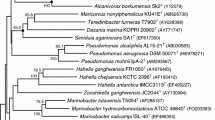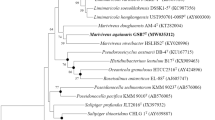Abstract
A Gram-stain negative, strictly aerobic, zeaxanthin-producing, rod-shaped, non-spore-forming bacterial strain which is motile by gliding, designated CC-AMWZ-3T, was isolated from surface seawater off coastal Kending, Taiwan. Strain CC-AMWZ-3T was found to share 93.3 % and 96.0–92.4 % pairwise 16S rRNA gene sequence similarity to Gramella echinicola KMM 6050T and other Gramella species, respectively, and formed distinct phyletic lineage during phylogenetic analysis. The major fatty acids were identified as C16:0, iso-C15:0, anteiso-C15:0, C16:1 ω6c and/or C16:1 ω7c and iso-C17:1 ω9c and/or C16:0 10-methyl. Polar lipids were found to include phosphatidylethanolamine, six unidentified lipids and three unidentified aminolipids. The DNA G+C content was determined to be 40.6 mol%. Menaquinone-6 was the sole respiratory quinone identified and triamine-sym-homospermidine was the predominant polyamine. Based on the polyphasic characteristics that are in line with those of Gramella species, in addition to distinguishing phylogenetic and phenotypic features, strain CC-AMWZ-3T appears to represent a novel species of the genus Gramella, for which the name Gramella planctonica sp. nov. (type strain CC-AMWZ-3T = JCM 18807T = BCRC 80553T) is proposed. In addition, emended descriptions of the species Gramella aestuarii and Gramella echinicola are also proposed.


Similar content being viewed by others
References
Altschul SF, Gish W, Miller W, Myers EW, Lipman DJ (1990) Basic local alignment search tool. J Mol Biol 215:403–410
Bauer M, Kube M, Teeling H, Richter M, Lombardot T, Allers E, Würdemann CA, Quast C, Kuhl H, Knaust F, Woebken D, Bischof K, Mussmann M, Choudhuri JV, Meyer F, Reinhardt R, Amann RI, Glöckner FO (2006) Whole genome analysis of the marine Bacteroidetes ‘Gramella forsetii’ reveals adaptations to degradation of polymeric organic matter. Environ Microbiol 8:2201–2213
Bernardet JF (2011) Family I. Flavobacteriaceae Reichenbach 1992. In: Krieg NR, Ludwig W, Whitman WB, Hedlund BP, Paster BJ, Staley JT, Ward N, Brown D, Parte A (eds) Bergey’s manual of systematic bacteriology, vol 4. Springer, New York, pp 106–111
Bernardet JF, Nakagawa Y, Holmes B (2002) Proposed minimal standards for describing new taxa of the family Flavobacteriaceae and emended description of the family. Int J Syst Evol Microbiol 52:1049–1070
Cho S, Chae S, Cho M, Kim T, Choi S, Han J, Kim Y, Joung Y, Joh K, Nedashkovskaya OI, Kim SB (2011) Gramella gaetbulicola sp. nov., a member of the family Flavobacteriaceae isolated from foreshore soil. Int J Syst Evol Microbiol 61:2654–2658
Collins MD (1985) Analysis of isoprenoid quinones. Methods Microbiol 18:329–366
Embley TM, Wait R (1994) Structural lipids of eubacteria. In: Goodfellow M, O’Donnell AG (eds) Chemical methods in prokaryotic systematics. Wiley, Chichester, pp 121–161
Felsenstein J (1981) Evolutionary trees from DNA sequences: a maximum likelihood approach. J Mol Evol 17:368–376
Felsenstein J (1985) Confidence limits on phylogenies: an approach using the bootstrap. Evolution 39:783–791
Fitch WM (1971) Towards defining the course of evolution: minimum change for a specific tree topology. Syst Zool 20:406–416
GCG (1995) Wisconsin Package Version 8.1 Program Manual. Madison, WI: Computer Group
Hameed A, Arun AB, Ho H-P, Chang C-M, Rekha PD, Lee M-R, Singh S, Young C-C (2011) Supercritical carbon dioxide micronization of zeaxanthin from moderately thermophilic bacteria Muricauda lutaonensis CC-HSB-11T. J Agric Food Chem 59:4119–4124
Hameed A, Shahina M, Lin S-Y, Sridhar KR, Young L-S, Lee M-R, Chen W-M, Chou J-H, Young C-C (2012) Siansivirga zeaxanthinifaciens gen. nov., sp. nov., a novel zeaxanthin-producing member of the family Flavobacteriaceae isolated from coastal seawater of Taiwan. FEMS Microbiol Lett 333:37–45
Hameed A, Shahina M, Lin S-Y, Cho JC, Lai W-A, Young C–C (2013a) Kordia aquimaris sp. nov., a zeaxanthin-producing member of the family Flavobacteriaceae isolated from surface seawater, and emended description of the genus Kordia. Int J Syst Evol Microbiol 63:4790–4796
Hameed A, Shahina M, Lin S-Y, Lai W-A, Hsu Y-H, Liu Y-C, Young C–C (2013b) Aquibacter zeaxanthinifaciens gen. nov., sp. nov., a zeaxanthin-producing bacterium of the family Flavobacteriaceae isolated from surface seawater, and emended descriptions of the genera Aestuariibaculum and Gaetbulibacter. Int J Syst Evol Microbiol 64:138–145
Heiner CR, Hunkapiller KL, Chen SM, Glass JI, Chen EY (1998) Sequencing multimegabase-template DNA with BigDye terminator chemistry. Genome Res 8:557–561
Jeong SH, Jin HM, Jeon CO (2013) Gramella aestuarii sp. nov., isolated from a tidal flat, and emended description of Gramella echinicola. Int J Syst Evol Microbiol 63:2872–2878
Joung Y, Kim H, Jang T, Ahn TS, Joh K (2011) Gramella jeungdoensis sp. nov., isolated from a solar saltern in Korea. J Microbiol 49:1022–1026
Kämpfer P, Kroppenstedt RM (1996) Numerical analysis of fatty acid patterns of coryneform bacteria and related taxa. Can J Microbiol 42:989–1005
Kim O-S, Cho Y-J, Lee K, Yoon S-H, Kim M, Na H, Park S-C, Jeon YS, Lee J-H, Yi H, Won S, Chun J (2012) Introducing EzTaxon-e: a prokaryotic 16S rRNA gene sequence database with phylotypes that represent uncultured species. Int J Syst Evol Microbiol 62:716–721
Kimura M (1980) A simple method for estimating evolutionary rates of base substitutions through comparative studies of nucleotide sequences. J Mol Evol 16:111–120
Lau SC, Tsoi MM, Li X, Plakhotnikova I, Dobretsov S, Wong PK, Qian PY (2005) Gramella portivictoriae sp. nov., a novel member of the family Flavobacteriaceae isolated from marine sediment. Int J Syst Evol Microbiol 55:2497–2500
Liu K, Li S, Jiao N, Tang K (2013) Gramella flava sp. nov., a novel member of the family Flavobacteriaceae isolated from the Southeastern Pacific. Int J Syst Evol Microbiol 64:165–168
Mesbah M, Premachandran U, Whitman WB (1989) Precise measurement of the G+C content of deoxyribonucleic acid by high-performance liquid chromatography. Int J Syst Bacteriol 39:159–167
Minnikin DE, O’Donnell AG, Goodfellow M, Alderson G, Athalye M, Schaal A, Parlett JH (1984) An integrated procedure for the extraction of bacterial isoprenoid quinones and polar lipids. J Microbiol Methods 2:233–241
Montero-Calasanz MD, Göker M, Rohde M, Spröer C, Schumann P, Busse H-J, Schmid M, Tindall BJ, Klenk H-P, Camacho M (2013) Chryseobacterium hispalense sp. nov., a plant growth-promoting bacterium isolated from a rainwater pond in an olive plant nursery and emendation of the species Chryseobacterium defluvii, Chryseobacterium indologenes, Chryseobacterium wanjuense and Chryseobacterium gregarium. Int J Syst Evol Microbiol 63:4386–4395
Murray RGE, Doetsch RN, Robinow CF (1994) Determinative and cytological light microscopy. In: Gerhardt P, Murray RGE, Wood WA, Krieg NR (eds) Methods for general and molecular bacteriology. American Society of Microbiology, Washington DC, pp 21–41
Nedashkovskaya OI, Kim SB, Lysenko AM, Frolova GM, Mikhailov VV, Bae KS, Lee DH, Kim IS (2005) Gramella echinicola gen. nov., sp. nov., a novel halophilic bacterium of the family Flavobacteriaceae isolated from the sea urchin Strongylocentrotus intermedius. Int J Syst Evol Microbiol 55:391–394
Nedashkovskaya OI, Kim SB, Bae KS (2010) Gramella marina sp. nov., isolated from the sea urchin Strongylocentrotus intermedius. Int J Syst Evol Microbiol 60:2799–2802
Reichenbach H (1992) The order cytophagales. In: Balows A, Trüper HG, Dworkin M, Harder W, Schleifer KH (eds) The prokaryotes. A handbook on the biology of bacteria: ecophysiology, isolation, identification, applications. Springer, New York, pp 3631–3675
Saitou N, Nei M (1987) The neighbor-joining method: a new method for reconstructing phylogenetic trees. Mol Biol Evol 4:406–425
Sasser M (1990) Identification of bacteria by gas chromatography of cellular fatty acids. USFCC Newsl 20:16
Scherer P, Kneifel H (1983) Distribution of polyamines in methanogenic bacteria. J Bacteriol 154:1315–1322
Shahina M, Hameed A, Lin S-Y, Hsu Y-H, Liu Y-C, Cheng I-C, Lee M-R, Lai W-A, Lee R-J, Young C–C (2013) Sphingomicrobium astaxanthinifaciens sp. nov., an astaxanthin-producing glycolipid-rich bacterium isolated from surface seawater and emended description of the genus Sphingomicrobium. Int J Syst Evol Microbiol 63:3415–3422
Smibert RM, Krieg NR (1994) Phenotypic characterization. In: Gerhardt P, Murray RGE, Wood WA, Krieg NR (eds) Methods for general and molecular bacteriology. American Society of Microbiology, Washington DC, pp 607–654
Tamura K, Peterson D, Peterson N, Stecher G, Nei M, Kumar S (2011) MEGA5: molecular evolutionary genetics analysis using maximum likelihood, evolutionary distance, and maximum parsimony methods. Mol Biol Evol 28:2731–2739
Thompson JD, Gibson TJ, Plewniak F, Jeanmougin F, Higgins DG (1997) The CLUSTAL_X windows interface: flexible strategies for multiple sequence alignment aided by quality analysis tools. Nucleic Acids Res 25:4876–4882
Tindall BJ, Rosselló-Móra R, Busse H-J, Ludwig W, Kämpfer P (2010) Notes on the characterization of prokaryote strains for taxonomic purposes. Int J Syst Evol Microbiol 60:249–266
Watts D, MacBeath JR (2001) Automated fluorescent DNA sequencing on the ABI PRISM 310 Genetic Analyzer. Methods Mol Biol 167:153–170
Acknowledgments
We would like to acknowledge Prof. Hans G. Trüper for nomenclatural advice and etymology. This work was supported in part by the Ministry of Education, Taiwan, R.O.C. under the ATU plan.
Author information
Authors and Affiliations
Corresponding author
Additional information
Light and transmission electron micrographs of cells of strain CC-AMWZ-3T and polyamine data of all three strains are available as Supplementary Material with the online version of this paper.
Electronic supplementary material
Below is the link to the electronic supplementary material.
Rights and permissions
About this article
Cite this article
Shahina, M., Hameed, A., Lin, SY. et al. Gramella planctonica sp. nov., a zeaxanthin-producing bacterium isolated from surface seawater, and emended descriptions of Gramella aestuarii and Gramella echinicola . Antonie van Leeuwenhoek 105, 771–779 (2014). https://doi.org/10.1007/s10482-014-0133-4
Received:
Accepted:
Published:
Issue Date:
DOI: https://doi.org/10.1007/s10482-014-0133-4




